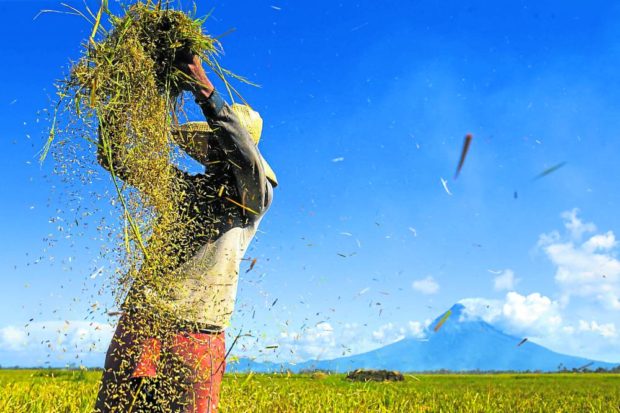
SAVING EVERY GRAIN In this photo taken in 2020, a farmer in Tiwi, Albay, collects leftover rice grain under the heat of the sun after putting it on a rice-threshing machine known in Bicol as “paghinimuro.” Despite the threat of the new coronavirus, farmers double their time to harvest so they can earn more for their families as demand for the staple has risen. —MARK ALVIC ESPLANA
LIGAO CITY—The island province of Catanduanes was chosen by the Philippine Rice Research Institute (PhilRice) to be one of the pilot testing areas for planting and growing golden rice, a variety packed with beta carotene developed by European scientists in the 1990s to combat vitamin A deficiency in children and pregnant or lactating mothers.
Dr. Victoria Lapitan, director of PhilRice Bicol, said golden rice would be planted in the towns of Viga and Virac and farmers in these towns were “excited” to try the variety.
Catanduanes and Quirino in the Cagayan Valley region were the provinces chosen by Philrice to be the first places in Luzon to grow golden rice.
In the Visayas, Samar and Antique were chosen, while Lanao del Norte, Agusan del Sur and Maguindanao were the pilot testing areas in Mindanao.
‘As safe as conventional rice’
According to the PhilRice website, golden rice was first developed by professors Ingo Potrykus, then of the Institute for Plant Sciences of the Swiss Federal Institute of Technology, and Peter Beyer, of the University of Freiburg in Germany.
The technology was donated to resource-poor farmers in developing countries like the Philippines amid suspicions against genetically modified foods in the 1990s. But it was only in 2018 when golden rice received positive food safety evaluations from Food Standards Australia New Zealand, Health Canada, and the United States Food and Drug Administration, said PhilRice, an agency attached to the Department of Agriculture (DA).
In December 2019, the DA’s Bureau of Plant Industry declared golden rice “as safe as a conventional rice” following a “rigorous biosafety assessment in the Philippines, the agency said.
In February, then Agriculture Secretary William Dar announced that 2022 would mark the start of massive production of golden rice seeds.
Nutritious variety
Glenn Peralta, science research specialist and field coordinator of the golden rice project at PhilRice, said they planted golden rice in the last week of June on a 2-hectare farm in Virac in partnership with Catanduanes State University and in Barangay Tambongon in Viga town through its farmers’ association.
Lapitan said the planting and growing of golden rice were similar to cultivating common rice varieties, and that it would also mature in 110 days. About 40 kilos of seeds were used to plant a 1-ha field and was projected to yield around 4 to 5 tons of grain, she said.“The taste and quality are not different from conventional rice. What makes it unique and different is the beta carotene content,” Lapitan said.
Beta carotene is a pigment found in some plants, fruits and vegetables that gives them their yellow and orange color. This pigment gives golden rice its yellow hue.
Beta carotene converts into vitamin A that the body needs for good vision and eye health. It also aids in strengthening the immune system and maintaining healthy skin and mucous membranes.
Public health concern
According to the Department of Science and Technology Food Research and Nutrition Institute, vitamin A deficiency remains a public health concern in the Philippines.
Most of those affected are children between 6 months and 5 years old, and pregnant or lactating mothers.
Lack of vitamin A contributes to high prevalence of undernutrition, anemia, blindness, and a weakened immune system. —MICHAEL B. JAUCIAN